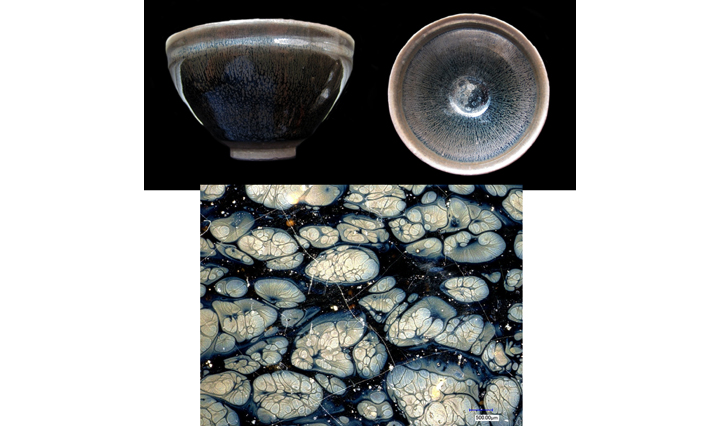
Jian ware (or Tenmoku) ceramic bowls, famous for their shiny black glaze and variable brown and silvery surface patterns known as “oil spot” and “hare’s fur,” were made during the Song dynasty in the Fujian Province of southeast China between 960 and 1279 AD. Now, modern scientific analysis reveals that Jian wares contain a rare compound only recently discovered and characterized by scientists and which is extremely difficult to create with modern techniques. Epsilon-phase iron oxide is marked by extremely persistent magnetization and could hold the key to better, cheaper permanent magnets used in data storage and other electronics.
A variety of analysis techniques, including optical microscopy, electron microscopy, Raman spectroscopy, and synchrotron x-ray techniques were used to assess the chemical composition and crystalline structures within the Jian ware glaze. The analysis revealed that the hare’s fur pattern contains small quantities of epsilon-phase iron oxide mixed with hematite, while oil-spot patterns boast large quantities of highly pure epsilon-phase iron oxide, a finding no one expected. Modern synthesis techniques have only managed to grow tiny crystals, often contaminated with hematite.
“What is amazing is that the ‘perfect synthesis conditions’ for epsilon-phase iron oxide were encountered 1000 years ago by Chinese potters,” says Catherine Dejoie, scientist at ETH Zurich and first author of the study. “The next step will be to understand how it is possible to reproduce the quality of epsilon-phase iron oxide with modern technology and to identify and extract synthesis conditions and other factors to obtain large crystals of pure epsilon phase.”

Work performed on ALS Beamline 12.3.2 and SSRL Beamline 2-3.
Citation: C. Dejoie, P. Sciau, W. Li, L. Noé, A. Mehta, K. Chen, H. Luo, M. Kunz, N. Tamura, and Z. Liu, “Learning from the past: Rare ε-Fe2O3 in the ancient black-glazed Jian (Tenmoku) wares,” Scientific Reports 4, 4941 (2014), doi:10.1038/srep04941.